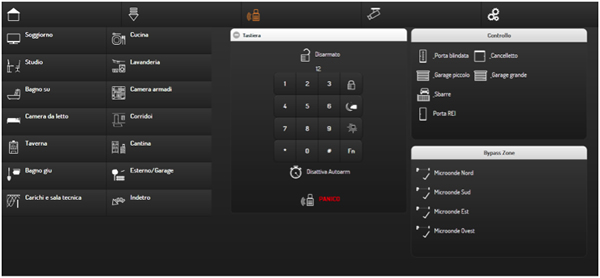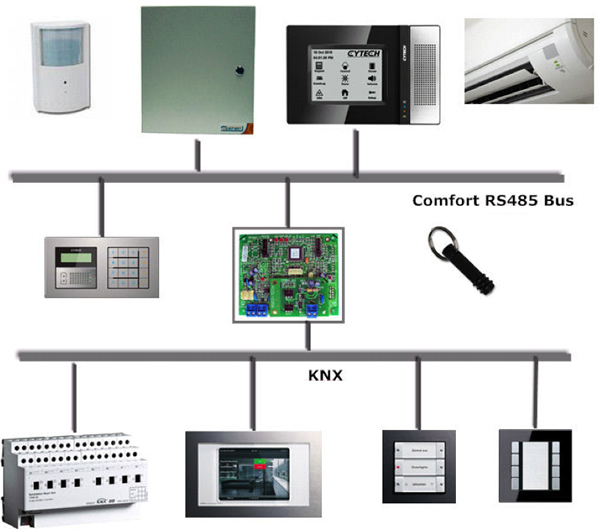 By Lu Yung Chiu, Cytech.
By Lu Yung Chiu, Cytech.
In the vast majority of homes where a KNX system is installed, an intruder alarm is often a basic requirement – even before the decision about what sort of automation system to install. By and large, these homes are at the higher end and more likely to be targeted by burglars. Hence it makes sense for the alarm system to be part of the KNX system.

An alarm system which is part of the same KNX system as the whole home, is a great benefit to the homeowner or resident. A KNX touchscreen or visualisation software could be used to arm and disarm the security system using a security code, and to see the state of the doors, windows, movement and other alarm sensors in the home. This means that the problem of non-matching alarm keypads and KNX switches can be resolved. Some screen examples are shown below:

Benefits of Integration with KNX
Operationally, having the alarm system as part of KNX means that the system can have the intelligence to set scenes depending on the alarm state. Examples of the benefits of integration include:
• When the alarm system is armed to Away Mode (occupants are leaving the home), the lights and appliances can be switched off, and heating or cooling can be turned down or off as required.
• When the alarm is disarmed by someone coming home, a welcome scene can be activated.
• When an intruder alarm occurs, interior and exterior lighting can be switched on or in an on/off flashing pattern to alert occupants and neighbours and light up the violated areas at night.
• Smoke and fire alarms can light up the exit path to leave the premises.
• The motion sensors connected to the alarm can turn on lights at night in areas such as the kitchen and stairs. KNX motion sensors can also supplement the alarm sensors for motion detection for the alarm, although the different characteristics of KNX motions sensors should be taken into account.
• In Vacation Mode, some of the lights and music can be turned on at semi-random times of the day or evening to simulate occupancy.
Challenges in Integration with KNX
Conventional non-KNX alarm systems can be linked to KNX only by hard-wiring from alarm outputs to KNX binary inputs. This means that only very basic integration can be achieved unless many hardwired inputs and outputs are connected between the systems, and there is little possibility for reprogramming of functions.
Most KNX integrators are not alarm installers and vice versa. Hence each party tends to focus on the type of system that they are comfortable with. This means that their customers miss out on the full benefit of having a KNX system and alarm in their home. More importantly, it means that these companies miss out on additional revenue, and a competitive advantage over other companies providing similar services in an increasingly competitive environment.

One possible solution is for KNX integrators to cooperate with an alarm company to install and commission the alarm system. A true KNX alarm system is installed just like a normal alarm, using the same alarm sensors, siren and other alarm accessories. The integration can be done at the very end, by connecting the KNX bus cable to the alarm system and doing a simple mapping of KNX group addresses to the alarm functions.
Practical Examples
There are various alarm systems that are manufactured by KNX member companies, but be aware that some only have rudimentary functions which would not be acceptable in a proper alarm installation. For example, there may not be semi-armed security modes (for Away, Night, Day etc), they may depend only on KNX motion (presence) sensors to trigger the alarm without any window or door contacts, they may lack different alarm types, cannot dial out to monitoring stations or phones, or do not have proper battery backup and charging.
One example of a fully-featured KNX alarm system is the Comfort integrated Intruder Alarm/Home Automation System from Cytech Technology. This can be used as a standalone alarm system, but with the UCM/KNX interface, it is connected to KNX via the KNX bus, and up to 256 KNX group addresses can be mapped to alarm events and conditions. The system is also able to learn and transmit infrared signals to most split-unit air-conditioners and AV systems, and has 64 Time Programs which can schedule the operation of KNX devices.
It also includes a keypad in the 55x55mm form factor that can be fitted with frames from many KNX manufacturers in order to match whatever KNX switches are mounted in the home.

Conclusion
Although conventional non-KNX alarm systems can be linked to KNX systems in a very basic way, and some KNX-based alarms offer rudimentary integration, there are fully-featured KNX alarms that offer all of the functions expected of a proper alarm installation.
The advantage to the user of integrating such a system within a KNX installation means that
they can enjoy all of these functions through a unified visualisation and control system, while
the advantage to the installer is a more comprehensive and attractive offer.
Lu Yung Chiu is a Director of Cytech Technology, manufacturer of the Comfort Intelligent Home System and KNX member.
You are welcome to comment on this article. See below.












